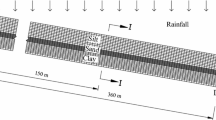Abstract
Covers of the nuclear waste repository are of great significance to the long-term safe storage and disposal of nuclear wastes. Capillary barriers have proven to be effective to resist the downward water seeping into the underlying nuclear wastes, especially in dry climate, and have been widely used worldwide. Infiltrating water is removed from the fine layer by evaporation or transpiration or through percolation into the coarse layer, which plays a critical role in preventing the water from further infiltration in the bulk wastes. In this paper, laboratory infiltration tests were conducted with an organic glass box, filled with fine-grained quartz sand in which a layer of coarse-grained quartz sand was emplaced horizontally or at various slopes (10° and 20°), and the capillary barrier effect under various conditions (different thickness, slop of coarse-grained quartz sand layer, and sprinkling intensity) was investigated in detail. The results show that the thickness of the underlying coarse layer plays a critical role in governing the performance of the capillary barrier. The efficiency of capillary barrier increases with increasing thickness and/or slope of the coarse layer, but decreases with increasing sprinkling intensity. For a sprinkling intensity of 20 mm/day, a 30-mm-thick coarse layer even emplaced horizontally can achieve 100% water diversion. In addition, a visible tracer test was performed with an inert red dyestuff to trace the streamlines; the results indicate that even with a 7-mm-thick coarse layer, the capillary barrier can offer marked ability to prevent water from percolating into the coarse layer. The findings could be useful for improving engineered uses of capillary barriers at waste repository sites.











Similar content being viewed by others
References
Aubertin, M., Cifuentes, E., Martin,V., Apithy, S., Bussière,B., Molson, J., et al. (2006). An investigation of factors that influence the water diversion capacity of inclined covers with capillary barrier effects. Unsaturated Soils, 613–624.
Henry, E. J. (2007). Analytical and numerical modeling assessment of capillary barrier performance degradation due to contaminant-induced surface tension reduction. Journal of Geotechnical and Geoenvironmental Engineering, 133, 231–236. doi:10.1061/(ASCE)1090-0241(2007)133:2(231).
Henry, K., Rahardjo, H., Leong, E.C. (2005). Behaviour of capillary barrier system constructed using residual soil. GSP 142 Waste Containment and Remediation, 1–15.
Jason, K. S., & John, S. S. (2001). Effect of soil-particle size contrast on capillary barrier performance. Journal of Geotechnical and Geoenvironmental Engineering, 127, 885–888. doi:10.1061/(ASCE)1090-0241(2001)127:10(885).
Mualem, Y. (1976). A new model for predicting the hydraulic conductivity of porous media. Water Resources Research, 12, 513–522. doi:10.1029/WR012i003p00513.
Ogorzalek, A.S., Shackelford, C.D. Benson C.H. (2005). Comparison of model predictions and field data for an alternative cover in a semi-arid climate. Mines and the Environment, CIM. [CD]
Porro, I. (2001). Hydrologic behavior of two engineered barriers following extreme wetting. Journal of Environmental Quality, 30, 655–667.
Qian, T. W., Guo, Q., Chen, F. R., et al. (2004). Migration of Sr, Nd and Ce in unsaturated Chinese loess under artificial sprinkling conditions: A field migration test. Water, Air, and Soil Pollution, 59, 139–150. doi:10.1023/B:WATE.0000049170.79305.6b.
Parent, S.-E., and Cabral, A. (2005). Material selection for the design of inclined covers with capillary barrier effect. GSP 142 Waste Containment and Remediation, 1–5.
Stormont, J. C., & Anderson, C. E. (1999). Capillary barrier effect from underlying coarse soil layer. Journal of Geotechnical and Geoenvironmental Engineering, 125, 641–648. doi:10.1061/(ASCE)1090-0241(1999)125:8(641).
Stormont, J. C., & Morris, C. E. (1998). Method to estimate water storage capacity of capillary barriers. Journal of Geotechnical and Geoenvironmental Engineering, 124, 297–302. doi:10.1061/(ASCE)1090-0241(1998)124:4(297).
Stormont, J. C. (1996). The effectiveness of two capillary barriers on a 10% slope. Geotechnical and Geological Engineering, 14, 243–267. doi:10.1007/BF00421943.
van Genuchten, M. T. (1980). A closed-form equation for predicting the hydraulic conductivity of unsaturated soils. Soil Science Society of America Journal, 44, 892–898.
Walter, M. T., Kim, J. S., Steenhuis, T. S., Parlange, J. Y., Heilig, A., Braddock, R. D., et al. (2000). Funneled flow mechanisms in a sloping layered soil: laboratory investigation. Water Resources Research, 36, 841–849. doi:10.1029/1999WR900328.
Wang, Z. M., Yao, L. G., & Jiang, H. (2003). Quantitative experiment of unsaturated water vadose through two-layer porous media. Radiation Protection, 23, 14–18.
Yang, H., Rahardjo, H., Leong, E. C., & Fredlund, D. G. (2004). A study of infiltration on three sand capillary barriers. Canadian Geotechnical Journal, 41, 629–643. doi:10.1139/t04-021.
Acknowledgments
This work was partially supported by the Natural Science Foundation of China (no. 40572168, no. 40810104035), the Natural Science Foundation of Shanxi Province (no. 20051060), the Special Fund for Talents Introducing and Developing of Shanxi province, Program for Young Academic Leaders of Higher Learning Institutions of Shanxi, the Auburn-TYUST Scholars Exchange Program, and an AWWRF grant (PFA 4057).
Author information
Authors and Affiliations
Corresponding author
Rights and permissions
About this article
Cite this article
Qian, T., Huo, L. & Zhao, D. Laboratory Investigation Into Factors Affecting Performance of Capillary Barrier System in Unsaturated Soil. Water Air Soil Pollut 206, 295–306 (2010). https://doi.org/10.1007/s11270-009-0106-9
Received:
Accepted:
Published:
Issue Date:
DOI: https://doi.org/10.1007/s11270-009-0106-9




